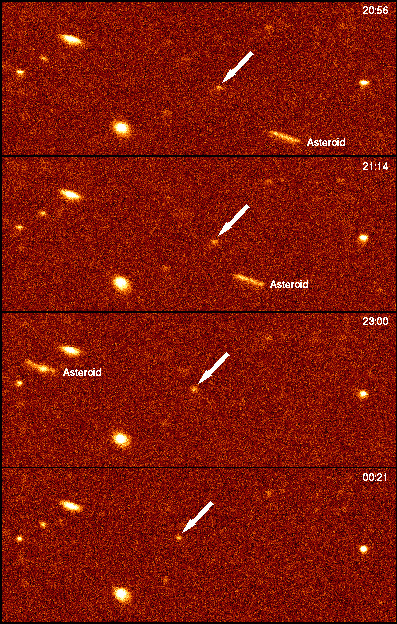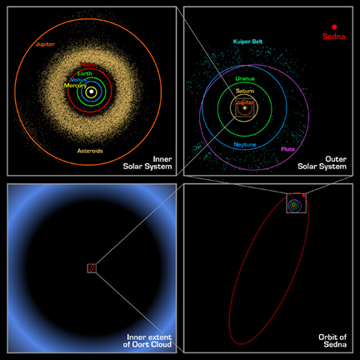Beyond Neptune: The Outer Solar System
Overview
For almost as long as history has been recorded, the entire Universe consisted of Earth, Mars, Venus, Mercury, the Sun, Jupiter, Saturn, and the Fixed Stars, plus some occasional, unexplained interloping comets. That was it, and the edge of the solar system was Saturn.
Over the past 400 years - since Galileo's telescope has led to a new understanding of celestial objects - the concept of the "solar system" has become more defined and has come to mean effectively the edge of the sun's influence - the heliopause, where charged particles from our star begin to give way to the interstellar medium.
This page is meant to address the general categories of objects and regions beyond the last planet, Neptune. It specifically does not address dwarf planets, though many of the dwarf planets are members of the objects discussed here.
Kuiper Belt
 |
| This is a set of 4 discovery images of the first discovered Kuiper Belt Object, 1992 QB1. The arrow shows the object moving against a background of "fixed" objects. Image is courtesy of David Jewitt (IfA, Hawai'i) and used with permission. |
Although most of the astronomical community refer to objects beyond Neptune as Kuiper Belt objects, most British astronomers call it the Edgeworth Belt. That is because it was in 1943 that Kenneth Edgeworth hypothesized that a belt of objects beyond Neptune may exist, having formed like the other planets from the primordial solar nebula. He was British, and published in the Journal of the British Astronomical Association (Edgeworth, 1943).
Eight years later*, Gerard Kuiper (pronounced "KI-per, like the greek letter χ) speculated effectively the same idea: Early in the solar system's history, a belt of icy objects would have formed beyond Neptune. However, he didn't think that it would still exist today, unlike Edgeworth. He proposed that Pluto would scatter the objects either towards the inner solar system or out of the solar system into the theoretical Oort Cloud (Kuiper, 1951).
The belt was theoretical until 1992, when the first member was discovered by David Jewitt and his graduate student, Jane Luu (shown in the images to the right). By photographing the same patch of sky over the course of several hours or days, and then looking for anything that moves, you can find asteroids, comets, or other objects. In this case, it was determined that the unexpected object (arrows) was at a distance that would put it in the Kuiper Belt. Confirmed by subsequent observations, it became the first KBO to be discovered.
It sparked a wave of further findings, and, to-date, over 1000 have been discovered. It is hypothesized that more than 70,000 exist that are larger than 100 km in diameter. The belt is believed to extend from Neptune's orbit to about 50 A.U. from the sun.
The Kuiper Belt solves one of the solar system's problems: The source of short-period comets. These are comets that have an orbital period of 200 years or less. It is now thought that the Kuiper Belt is the source of these objects, such as comet Halley or Encke, and that it is due to occasional gravitational interactions that they get launched into the inner solar system.
KBOs are very difficult to detect due to their vast distances from the sun and very low surface reflectivity. Once identified, it is also very difficult to determine anything about them, even their size, without making untestable assumptions (such as how much light they reflect).
*Note that the reference that is often given for this is from his "On the Origin of the Solar System" paper within the "Astrophysics: A Topical Symposium." However, the article I found is one of the same name but in the Proceedings of the National Academy of Science (Kuiper, 1951). It may or may not be the correct citation.
Scattered Disk Objects
The scattered disk is a region beyond Neptune's orbit that covers the same region of the solar system as the Kuiper Belt. The difference between the Kuiper Belt and scattered disk is in its name: The scattered disk objects have highly eccentric orbits with large orbital inclinations. Kuiper Belt objects, but contrast, generally orbit closer to the plane of the solar system and do not have large eccentricities.
The origin of the scattered disk objects are thought to have come from interactions with the gas giant planets (Jupiter, Saturn, Uranus, Neptune). A close gravitational approach could cause the smaller object to be flung to the outer solar system and have scattered disk characteristics.
Oort Cloud
Another outer region of the solar system is the Oort Cloud, a theoretical cloud of comets that surrounds the solar system out to a distance of two light-years. The Oort Cloud was first proposed by Jan Oort in 1950 (Oort, 1950). This "land of comets" contains comet-forming nuclei left over from the formation of the solar system. It is currently thought that this is the origin of long-period comets. The way they enter the inner solar system is by gravitational pushes usually caused by a passing star.
 |
| This shows a scale rendering of the orbit of Sedna compared with the inner solar system, outer solar system and Kuiper Belt, and Oort Cloud. Image is from a NASA press release. |
The Oort Cloud is a generally accepted theory, though no member of the Oort cloud has been conclusively found. The object "Sedna" that was announced on March 15, 2004, is a possible member of the inner Oort Cloud. Its orbit takes it to within 90 A.U., but as far out as about 900 A.U. from the Sun. It is believed to be about 75% Pluto's size, with a radius of 950±150 km. It is the coldest object in the known solar system with a surface temperature of -240 °C (-400 °F), and it is also a very red object - the reddest in the solar system other than Mars. It was originally thought that Sedna had a moon, but that was based upon an erroneous measurement of its "day," which was more accurately determined in 2005 to be about 10 hours instead of 20 Earth days.
Sedna is the farthest known solar system object, and it has a period of 10,500 years. It is still, however, not representative of the Oort Cloud. As shown in the lower left panel of the diagram on the right, Sedna is still well within what was believed to be the inner boundary of the Oort Cloud. For this reason, the Oort Cloud is still hypothetical, with no direct evidence that it exists. But the search is still on.
Heliopause
While the Oort Cloud represents the edge of the solar system in terms of the sun's gravitational dominance, another way to think about the boundary of the solar system is where the sun's physical influence ends - where its solar wind can no longer carve a bubble out of the interstellar medium. This region is known as the heliopause.
This region is a fluctuating boundary that is estimated to be approximately 17.6 billion miles (120 A.U.) away. Note that this is within where the Oort Cloud is thought to reside. The two Voyager space craft should cross this region within the next years as they "leave" the solar system to become the first terran interstellar travelers.
- Click here to download a movie that shows the heliopause. (MPEG file, 7.6 MB; Originally from a NASA Press Release)